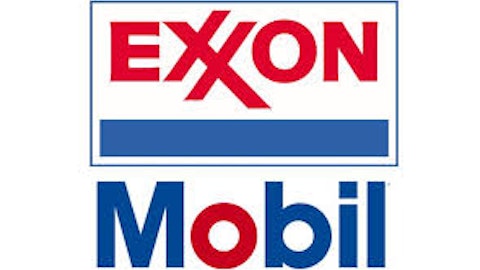There’s a lot of hype surrounding offshore drilling, especially as the Deepwater Horizon incident becomes a mere blip in investors’ rear-view mirrors. The number of deepwater rigs in the Gulf of Mexico is quickly approaching 40, up from the 33 that were in the Gulf in 2010.

This is thanks to its FlexRigs. The beauty of these FlexRigs is they move faster and drill quicker/more efficiently than conventional rigs. But that’s not all–the company’s balance sheet appears rock solid, with a debt-to-capital ratio of only 5% and a current ratio that’s over 3.0. Thanks to this solid balance sheet, the company pays a 3% dividend yield.
With this, Helmerich & Payne, Inc. (NYSE:HP) is back near its all-time highs of 2008:

This comes as its rig utilization is over 80% in the land-drilling segment. So what will help drive Helmerich higher? The majority of HP’s rigs are under long-term contracts, which provides relative stability and insight into future cash flows.
More positives for the company? A couple of Helmerich & Payne, Inc. (NYSE:HP)’s largest customers are well- known operators in the oil and gas industry, including Occidental Petroleum Corporation (NYSE:OXY) and Exxon Mobil Corporation (NYSE:XOM). Both companies are turning to more land drilling, especially Occidental, which is looking to capitalize on its California and Permian Basin assets.
Helmerich’s June-ended quarterly EPS came in at $1.44, compared to $1.37 for the same period last year, thanks in part to a 4% rise in the average rig margin per day in U.S. land drilling.
Helmerich & Payne, Inc. (NYSE:HP)’s drilling contract backlog is now up to $3.3 billion. The real beauty about this backlog is that it helps give clarity, certainty if you will, to the driller’s solid dividend. As a result, earlier this year the company upped its dividend from $0.15 quarterly to $0.50.
Drilling elsewhere
A couple of notable competitors include Rowan Companies PLC (NYSE:RDC) and Patterson-UTI Energy, Inc. (NASDAQ:PTEN). Rowan is a contract-oil and natural-gas driller. It used to be a big Herlmerich competitor, but in 2011 it divested its land drilling and manufacturing divisions. The company now focuses on offshore drilling.
Rowan Companies PLC (NYSE:RDC) also has a low debt-to-capital ratio of 15%. This should help the company with its transition to a deepwater operator. Analysts expect the company to post impressive EPS growth on the back of this increased deepwater exposure. 2013 EPS is expected to be $2.23, but 2014 is expected to jump to $3.52.
Rowan Companies PLC (NYSE:RDC) has 31 jack-up rigs and is in the process of building four ultra-deepwater drillers, expected to come online between 2013 and 2015. Its first drillship is already contracted by Repsol for a period of three years, to begin in 2014. The rig will be used in West Africa and will receive a day-rate of $655,000. Rowan Companies PLC (NYSE:RDC) is still looking for opportunities for the other three drillships. The thing that makes Rowan relatively unattractive is the robust competition in the sector, where the likes of Transocean LTD (NYSE:RIG) and ENSCO PLC (NYSE:ESV) tend to dominate the market.
Onshore
Patterson-UTI Energy, Inc. (NASDAQ:PTEN) is the second-largest North American operator of land-based drilling rigs. The company owns 314 land-drilling rigs across the U.S. Patterson’s contract-drilling segment generates around 65% of revenue, while its pressure- pumping services make up the majority of the rest of revenues, at 30%.
Back in 2010, Patterson-UTI Energy, Inc. (NASDAQ:PTEN) snatched up the assets of Key Energy Services, which was an onshore well-service rig provider. This really helped the company expand into the shale-drilling market. One of the benefits for Patterson is that it’s trading out older rigs for new ones.
Patterson-UTI Energy, Inc. (NASDAQ:PTEN) plans to retire some 36 rigs from its fleet. This is a positive for two reasons–one, it should increase the utilization of its fleet, as the low natural-gas prices have lead to market overcapacity. In addition, Patterson’s newer rigs will continue to be well received given their efficiency in drilling the more challenging wells. Thus, these rigs demand higher day-rates.
Bottom line
As more and more energy companies look to move onshore, Helmerich should be a big benefactor. Many major oil and gas companies have made the move from offshore drilling to take part in the rapid-growth onshore shale plays, such as the Bakken and Eagle Ford. As far as the major onshore drillers go, Helmerich & Payne, Inc. (NYSE:HP) is trading the cheapest:

Carrying over $480 million in cash and just $235 million in debt, Helmerich & Payne, Inc. (NYSE:HP) appears to be a solid investment. I like the company because it’s cash rich, trading at 7.8 times operating cash flow with a return on equity of 17.8%.
Marshall Hargrave has no position in any stocks mentioned. The Motley Fool has no position in any of the stocks mentioned.
Marshall is a member of The Motley Fool Blog Network — entries represent the personal opinion of the blogger and are not formally edited.
Copyright © 1995 – 2013 The Motley Fool, LLC. All rights reserved. The Motley Fool has a disclosure policy.





